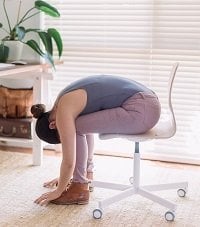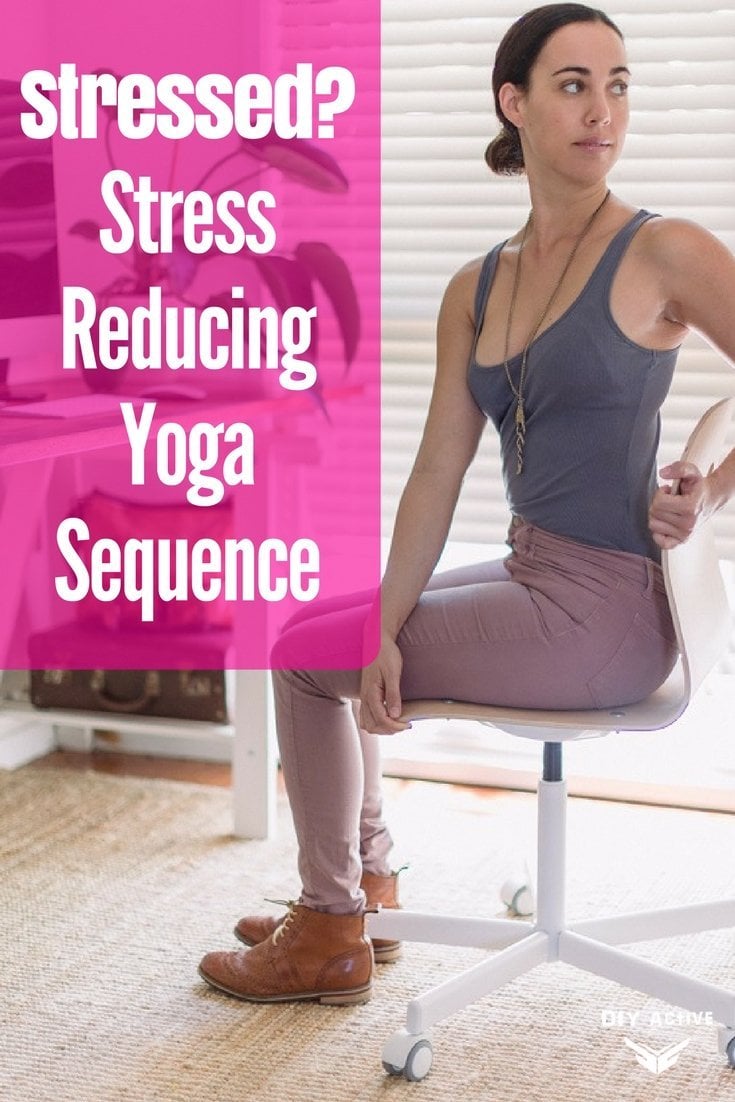Stress takes its toll on our health in a variety of ways including trouble sleeping, poor digestion, lack of mental focus, low energy levels, and anxiety. It’s clearly a no-brainer that we should try to reduce stress in our lives but that’s often easier than done. Well, have you tried at home yoga?
Yoga can help reduce stress and release tension…
A simple yoga practice however can mitigate the effects of stress on our health.
By tuning into our breath we trigger our body’s built-in relaxation response; by slowing down and taking a break from our daily grind, we also have a precious opportunity to reflect and shift our mental outlook. Just changing the way we react to our stress can have a profound effect on our health and wellbeing.
The yoga sequence below focuses on dissolving muscular tension around the neck, shoulders and back that accumulates with stress.
A simple breath centered meditation is also included as well as options for adapting the poses to be done from your office chair (that means no excuses!).
I know from personal experience that when stress levels are high, we convince ourselves that we don’t have time to spare for a yoga practice.
Yet, meditation has been shown to increase efficiency and productivity. So, no matter how busy you are, it’s worth taking even just a few minutes to focus on your breath and reduce stress.
You may be surprised to feel as a result of the practice that time is actually on your side. Here’s the full sequence with poses broken down below:
(Image credit: Joshua Oldfield)
Trap Release & Neck Stretch
 To begin, find a comfortable seat on a yoga mat or chair. If you’re sitting on the floor, sit up on the edge of a blanket or onto a block. Bend your knees to cross your right shin in front of your left and bring your feet under your knees.
To begin, find a comfortable seat on a yoga mat or chair. If you’re sitting on the floor, sit up on the edge of a blanket or onto a block. Bend your knees to cross your right shin in front of your left and bring your feet under your knees.
If you’re seated in your office chair, make sure to place your feet firmly on the ground (scoot forward on your chair if necessary) and sit up with a tall spine.
Reach your left arm out to the side and gently lower your right ear to your shoulder to feel a stretch in the left side of your neck and top of the shoulder. If you’d like to increase the intensity, you can drape your right arm over your head.
Take 5 deep full breaths then repeat on the other side.
Gomukasana Arms – Shoulder stretch
 If you’re seated on the ground, go ahead and cross your left shin in front of the right this time, or stay seated in your chair.
If you’re seated on the ground, go ahead and cross your left shin in front of the right this time, or stay seated in your chair.
Part 1
Reach your right arm overhead and bend your elbow so that your hand lightly grazes the back of the neck.
Hold your right elbow with your left hand. Your back may arch as you take your arm overhead; if you feel a strain in your low back, draw your front ribs in towards your spine to help reduce the arch and strain.
Take 3-5 breaths and then switch sides.
Part 2
 Now take your right arm behind your back. Depending on your mobility here, your forearm will stay at your lower back or you might walk your hand up your spine, in between the the shoulder blades as pictured. Use your left hand to hold onto your right forearm or elbow.
Now take your right arm behind your back. Depending on your mobility here, your forearm will stay at your lower back or you might walk your hand up your spine, in between the the shoulder blades as pictured. Use your left hand to hold onto your right forearm or elbow.
Stay here for 3 to 5 breaths. Gently release and take a moment with your arms at the sides of your torso before repeating the pose on the other side.
This one can be intense. Go slowly and back off if you feel any pain.
I particularly like this stretch for people who sit in front of computers for hours on end.
This stretch targets the external rotators of the arm which can often be tight and weak due to sustained poor posture at the computer.
Twist
 From a seated position on the floor, place your left hand on your right knee and your right hand on the floor behind you. Lengthen up through your spine as you inhale and twist to the right as you exhale. Stay for 3-5 breaths, then switch sides.
From a seated position on the floor, place your left hand on your right knee and your right hand on the floor behind you. Lengthen up through your spine as you inhale and twist to the right as you exhale. Stay for 3-5 breaths, then switch sides.
If you’re twisting from your chair, sit up tall and place your feet firmly on the ground. Hold the back of the chair with your right hand and the side of the chair with your left hand. Inhale to lengthen the spine, and exhale as you twist to the right.
Stay for 3-5 breaths, then switch sides.
Gentle twists are rejuvenating for the spine and internal organs. They help to rehydrate the vertebral discs of the spine which can potentially get irritated from excessive sitting during periods of high stress when we tend to work day and night.
By gently compressing the abdominal organs, twists can also promote better digestion.
Garudasana – Eagle Balancing Pose
 Now come to a standing position with the feet hip width apart. Cross your right arm underneath your left arm, bend the elbows and bring your forearms toward each other. If you can, touch the inside of the palms together, too. Then bend your knees and cross your right leg over your left.
Now come to a standing position with the feet hip width apart. Cross your right arm underneath your left arm, bend the elbows and bring your forearms toward each other. If you can, touch the inside of the palms together, too. Then bend your knees and cross your right leg over your left.
Focus your eyes on one point and try to find your balance.
Take 3-5 breaths here, and then switch sides.
Finding steadiness in the pose helps to promote the clarity and focus that we struggle to find when stress levels are high.
You have the option here to just do the arms portion of this pose seated in your office chair. I recommend lifting your elbows and chin up slightly to get more of a stretch in the upper back.
Forward Fold
 From a standing position with the feet hip width apart, bend your knees a lot as you fold forward.
From a standing position with the feet hip width apart, bend your knees a lot as you fold forward.
The key here is to bend your knees as much as you personally need in order to lay your belly onto the thighs. Rest your hands on the ground or if you’re comfortable you can grab a hold of opposite elbows. Drop your head and relax your neck completely. Imagine your spine cascading towards the floor like a waterfall.
Take 3 to 5 breaths in this posture.
At work – you can still gain the benefits of this forward fold by doing it in your chair. Scoot forward so that you’re sitting on the edge of your chair. Place the belly on the thighs and bring your hands to the floor.
Forward folds have a calming and soothing effect on our nervous system. It’s also an opportunity to check in with our mental outlook as we close the eyes and turn the gaze inwards.
Take a moment to reflect on your stress levels. Is there somewhere in your life where you are overreacting or overexerting? What would be possible if you were to soften your reaction or efforts?
Side Bend
 This pose unravels tension in the side of the body and creates space between the ribs, making it easier to take those deeper, calming breaths.
This pose unravels tension in the side of the body and creates space between the ribs, making it easier to take those deeper, calming breaths.
At home: Lie down on your back. Without lifting your hips off the ground, walk your legs and your upper body over to the right side to make a banana like shape with your body. If you’re comfortable, cross your left ankle over your right and clasp your hands. This stretch will build in intensity so go slowly at first until you become more familiar with the pose.
Stay here for 5-10 breaths.
To come out, uncross your legs and slowly inch your way back to the center. Pause for a minute with your arms by your sides to notice any sensations or differences side to side. Then repeat on the other side. When you’re finished with the left side, again come back to the center but this time stay here for 5 minutes if you can to finish your practice.
At work: Stand up with your feet hip width distance apart. On an inhale breath, interlace your fingers and turn your palms to face the ceiling as you reach your arms overhead. Exhale and bend over to the right side.
Take 2 more breaths here. To come out of the pose, on an inhale come back to the center and as you exhale, bend to the left. Take another 2 breaths, then come back to center and release your arms by your sides.
Meditation
 Find a comfortable seat once more and close your eyes. Start by noticing the movement of the breath in your body. Take 3 or 4 rounds of breath, simply observing the sensations. Then, count your inhale and make your exhalation the same count. For example, if you counted to 4, exhale to a count of 4.
Find a comfortable seat once more and close your eyes. Start by noticing the movement of the breath in your body. Take 3 or 4 rounds of breath, simply observing the sensations. Then, count your inhale and make your exhalation the same count. For example, if you counted to 4, exhale to a count of 4.
Do another 2 rounds of making your inhale and exhale breath the same count. Now begin to lengthen the exhale so that it’s 1 or 2 counts longer than your inhale. With our example, you’ll now exhale to a count of 5 or 6.
The key here is to stay calm and relaxed and not to over exert yourself — only lengthen your exhale to what is comfortable for you. Repeat for another 2 more rounds. Next come back to a natural breath without counting or manipulating the breath. Again, notice the sensation of breath in the body.
Notice the effect that the meditation has on your state of mind and overall feeling of wellbeing.
To conclude the practice, consider how you could take your yoga practice off the mat (or out of your chair!). Take a few moments to envision one or two easy manageable changes you can make at work or home to reduce your stress levels.
Wrap-Up
With as much stress we have in our lives, or at the office, it’s always a good idea to take the time to find your center.
At home or at the office yoga is a great way to deal with the daily grind while increasing your flexibility and improving your mood.
Another great way to relieve stress through yoga is by using an alternative method called aerial yoga, and the only thing that is required is by installing an aerial yoga swing into your home or office. It opens up the door to new and alternative styles of yoga and comes with a host of stress-free and relaxation benefits.
So, the next time drama in your life or at the office gets you down, try this great yoga sequence to reduce stress and release tension!

